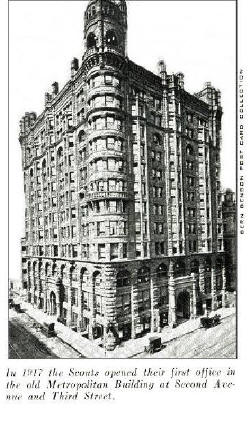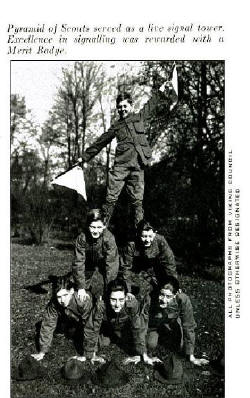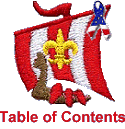
|
||
|
|
Scouting History in the Viking Council 1910-1976
| |
Cover 1 2 3 4 5 6 7 8 9 10 |
|
 Originally the Scout movement embraced boys from 11 to 15
years of age, but by 1916 Baden-Powell had introduced the concept of Cub
Scouts to satisfy the needs of younger boys who were to have their own
uniform, their own badges and system of training. By 1949 the spectrum
of Scouting was expanded to include Cub Scouts from 8 to 10; Boy Scouts from
11 to 14; and Explorer Scouts from 14 to 21.
Originally the Scout movement embraced boys from 11 to 15
years of age, but by 1916 Baden-Powell had introduced the concept of Cub
Scouts to satisfy the needs of younger boys who were to have their own
uniform, their own badges and system of training. By 1949 the spectrum
of Scouting was expanded to include Cub Scouts from 8 to 10; Boy Scouts from
11 to 14; and Explorer Scouts from 14 to 21.
Why was the name "Boy Scout" chosen for this new idea? Baden-Powell said it was based on the principal of an education-game - a recreation in which the boy would be led to educate himself. He called it "Scouting" because the name suggested adventure, and also because the idea of being in a patrol and a member of a group would appeal to young boys.
When he returned to England from Africa in 1908, he learned that his program for men was being adopted and used in English schools for boys. Baden Powell then refined his program to better fit young men.
 It
was in 1908 that William D. Boyce, an American, met an unidentified Scout
while traveling in England. He was in the heart of London in a
particularly thick fog looking for a business friend, and became hopelessly
lost when a young man came up and offered free assistance. Boyce was
deeply impressed and searched out additional information about this new
concept for training young men. When he returned he took steps to
introduce and develop the Boy Scout idea in this country. On February
8, 1910, the "Boy Scouts of America" was incorporated under the laws of the
District of Columbia by Boyce, and the National Council Office was
established early the next year in New York City. The movement spread
quickly across the country and arrived in Minneapolis three months later.
It
was in 1908 that William D. Boyce, an American, met an unidentified Scout
while traveling in England. He was in the heart of London in a
particularly thick fog looking for a business friend, and became hopelessly
lost when a young man came up and offered free assistance. Boyce was
deeply impressed and searched out additional information about this new
concept for training young men. When he returned he took steps to
introduce and develop the Boy Scout idea in this country. On February
8, 1910, the "Boy Scouts of America" was incorporated under the laws of the
District of Columbia by Boyce, and the National Council Office was
established early the next year in New York City. The movement spread
quickly across the country and arrived in Minneapolis three months later.
| |
Cover 1 2 3 4 5 6 7 8 9 10 |
|
|
The
ScoutingBSA.org web site is a
legacy site of the Viking Council BSA, now Northern Star Council.
|
|
||||||
Last Update May 15, 2023

.jpg)